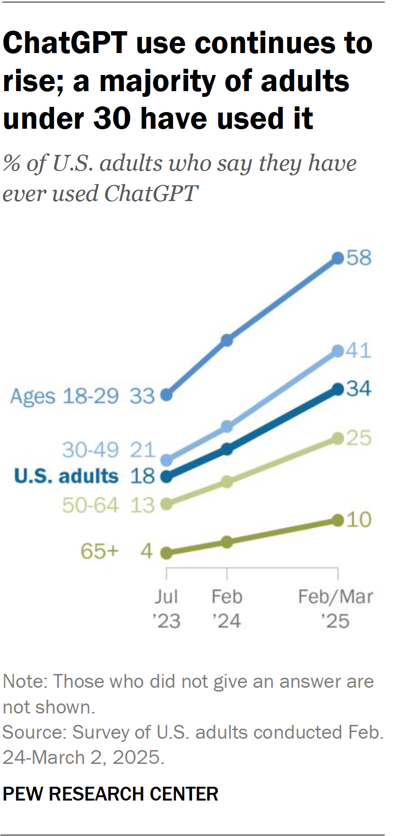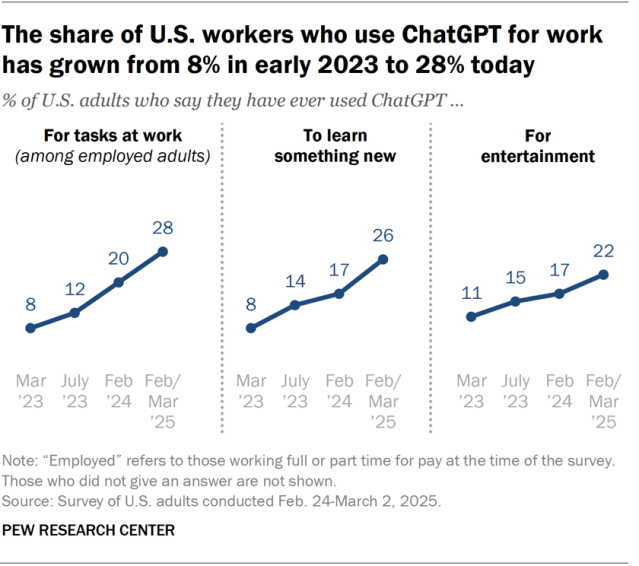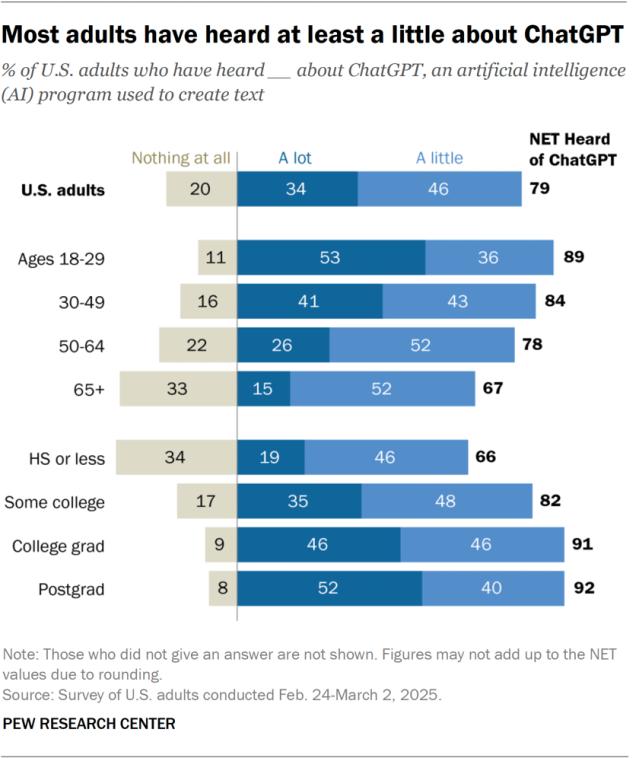The share of Americans who have used ChatGPT, an AI chatbot released in November 2022, has roughly doubled since summer 2023. Today, 34% of U.S. adults say they have ever used ChatGPT, according to a Pew Research Center survey. That includes a 58% majority of adults under 30.
Still, 66% of Americans have not used the chatbot, including 20% who say they’ve heard nothing about it.
Below, we explore the following questions:
Who has used ChatGPT?

Use of ChatGPT is up across age groups and education levels, but some groups remain more likely than others to have used it.
Differences by age
As in previous years, young adults stand out in their ChatGPT use. Today, 58% of adults under 30 say they have used it, up from 43% in 2024 and 33% in 2023. While use is rising in older age groups as well, they remain less likely to have used ChatGPT:
- 41% of adults ages 30 to 49 have used it.
- 25% of those 50 to 64 say the same.
- 10% of those 65 and older report ever using ChatGPT.
Differences by education
Adults with higher levels of formal education are more likely than those with less education to have used ChatGPT. About half of those with a bachelor’s degree only (51%) or a postgraduate degree (52%) say they have used ChatGPT, compared with smaller shares of those with some college experience (33%) or a high school degree or less education (18%).
How have Americans used ChatGPT?

Since March 2023, we’ve also asked about three ways people might use ChatGPT: for work, to learn something new or for entertainment. We see growth in all three areas.
In two years, the share of employed adults who say they use ChatGPT for work has risen by 20 percentage points to 28%. That includes an 8-point increase since last year.
Other Center research shows workers have mixed feelings about its use and expect it to have a major impact on jobs.
Looking at other use cases for ChatGPT among U.S. adults overall:
- 26% have used it for learning, up from 8% in March 2023.
- 22% have used it for entertainment, up from 11%.
Differences by age

Use of ChatGPT for these reasons has risen since March 2023 across age groups. But younger adults are more likely than older adults to use ChatGPT in these ways. For example, 38% of employed adults ages 18 to 29 say they have used ChatGPT on the job. This compares with:
- 30% of those ages 30 to 49
- 18% of those 50 and older
Some 46% of all adults under 30 have used it to learn something new. And 42% have used it for entertainment.
Still, some older adults have used ChatGPT in these ways. About three-in-ten adults ages 30 to 49 say they’ve ever used the chatbot for learning and entertainment. The share of adults 50 or older who say the same drops further.
Differences by education
Adults with higher levels of formal education also stand out in using ChatGPT at work. Some 45% of employed adults with a postgraduate degree say they have used it this way, compared with:
- 36% of those with a bachelor’s degree
- 25% of those with some college experience
- 17% of those with a high school education or less
Among all U.S. adults, those with a bachelor’s degree only (34%) or a postgraduate degree (39%) are the most likely to use the chatbot for learning.
How aware are Americans of ChatGPT?

Awareness of ChatGPT has risen over time: When we first asked about it in March 2023, 58% said they had heard at least a little about it. Now, most Americans – 79% – have heard at least a little about it, including 34% who have heard a lot about it.
Differences by age
Majorities of adults of all ages have heard about the chatbot. But adults under 30 stand out for hearing a lot about it – 53% say this, compared with 15% of those 65 and older.
Differences by education
Regardless of education level, majorities of adults have heard at least a little about ChatGPT. But about half of adults with a postgraduate degree say they’ve heard a lot about it. That compares with 19% of those with a high school degree or less education.
Note: This is an update of a post originally published on March 26, 2024. Here are the questions used for this analysis, the topline and the survey methodology.

